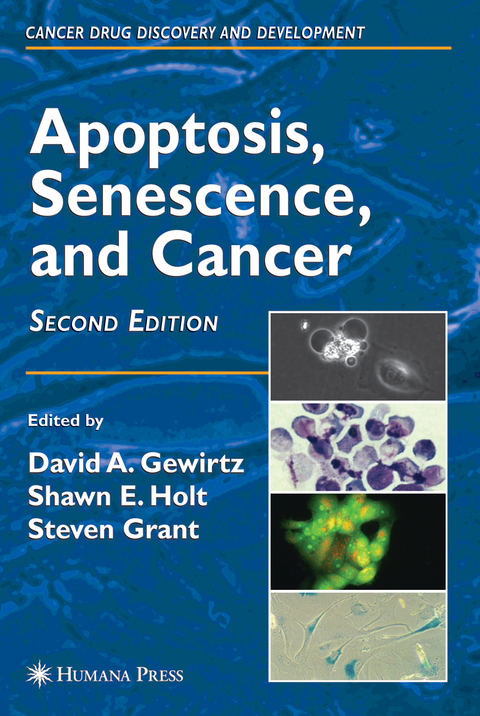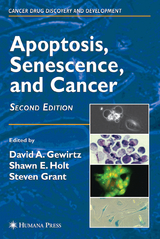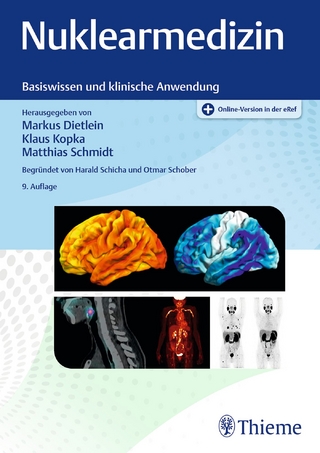Apoptosis, Senescence and Cancer
Humana Press Inc. (Verlag)
978-1-58829-527-9 (ISBN)
Apoptosis, Senescence and Cancer provides insight into established practices and research into apoptosis and senescence by thoroughly examining novel and emerging techniques and research in the fields of cell death pathways, senescence growth arrest, drugs and resistance, DNA damage response, and other topics which still hold mysteries for researchers.
The volume is divided into six easy to follow sections. The first is Apoptosis and Alternative Modes of Cell Death, followed by chapters on Telomeres and Telomerase, Senescence, Genomic Instability and Tumorigenesis. The third part covers DNA Damage Response, Signaling Pathways and Tumorigenesis, while the fourth delves into Resistance and Sensitization. The book concludes with Established Cancer Therapies and a section which looks toward the future with Recent and Developing Cancer Therapies.
In total, this volume provides basic scientists and clinicians with a deeper and more complete understanding of the cellular responses of malignancies which may determine the effectiveness of treatment, both in the initial stages of the disease as well as in disease recurrence.
Apoptosis and Alternative Modes of Cell Death.- The Intrinsic Pathway of Apoptosis.- The Extrinsic Pathway of Apoptosis.- Evaluating the Importance of Apoptosis and Other Determinants of Cell Death and Survival.- Mitotic Catastrophe.- Autophagy and Autophagic Cell Death.- Regulation and Function of Detachment-Induced Cell Death (Anoikis) in Cancer Progression and Metastasis.- Telomeres and Telomerase, Senescence, Genomic Instability, and Tumorigenesis.- Structure and Function of the Telomere.- Overview of Senescence.- Contributions of Telomerase to Tumorigenesis.- The Role of Telomeres in Genomic Instability.- DNA Damage Response, Signaling Pathways, and Tumorigenesis.- Overview of the DNA Damage Checkpoint.- Interactions Between Myc- and Cyclin-Dependent Kinase Inhibitors in Cancer.- Interplay Between ?H2AX and 53BP1 Pathways in DNA Double-Strand Break Repair Response.- DNA-Dependent Protein Kinase in Repair, Apoptosis, Telomere Maintenance, and Chemotherapy.- Resistance and Sensitization.- Resistance/Signaling Pathways.- Ceramide and Multidrug Resistance.- Chemo- and Radiosensitization Through Inhibition of PI3K/Akt Signaling.- The Advancement of Epidermal Growth Factor Receptor Inhibitors in Cancer Therapy.- Established Cancer Therapies.- Antimetabolites.- Topoisomerase I Poisons and Apoptotic Topoisomerase I-DNA Complexes.- Perturbations of Cellular Functions by Topoisomerase II Inhibitors.- The Significance of Poly-Targeting in Apoptosis Induction by Alkylating Agents and Platinum Drugs.- Contributions of Apoptosis and Senescence to Cytotoxicity Produced by Microtubule-Stabilizing Agents.- Tyrosine Kinase Inhibitors.- Recent and Developing Cancer Therapies.- Monoclonal Antibodies in Lymphomas.- Role of Apoptosis in Anti-Angiogenic Cancer Therapies.- PhotodynamicTherapy-Induced Apoptosis.- Modulation of TRAIL Signaling for Cancer Therapy.
From the reviews of the second edition:"The book provides a comprehensive view in the field of apoptosis, senescence, and cancer therapies. I recommend this book to PhD students in clinical and experimental oncology, pharmacology as well as to lecturers in biological disciplines." (J. Sedlák, Neoplasma, September, 2008)"This book aims to explain basic biological processes and signalling pathways and to link that knowledge to the anticancer drugs associated with those pathways. … The book is generally well written and extremely informative. The information within is as up to date … . I have certainly learnt a lot from reading this book. … recommending it to a laboratory/clinical group or library for purchase." (A Young, British Journal of Cancer, Vol. 100 (5), 2009)“The purpose of the book is to contribute to an understanding of the growth arrest and cell death pathways mediating the response to chemotherapy in tumour cells. … provides basic scientists and clinicians with a deeper and more thorough understanding of the cellular responses of malignant cells to common therapeutic modalities, which may determine the effectiveness of the anti-cancer treatment. This work is an interesting overview of the topics described above and it is well written by experts in the field.” (Sylvie Rottey, Acta Clinica Belgica, Vol. 65 (2), 2010)
| Reihe/Serie | Cancer Drug Discovery and Development |
|---|---|
| Zusatzinfo | 5 Illustrations, color; 64 Illustrations, black and white; XVII, 599 p. 69 illus., 5 illus. in color. |
| Verlagsort | Totowa, NJ |
| Sprache | englisch |
| Maße | 178 x 254 mm |
| Themenwelt | Medizin / Pharmazie ► Medizinische Fachgebiete ► Onkologie |
| Medizin / Pharmazie ► Medizinische Fachgebiete ► Pharmakologie / Pharmakotherapie | |
| Medizinische Fachgebiete ► Radiologie / Bildgebende Verfahren ► Nuklearmedizin | |
| ISBN-10 | 1-58829-527-3 / 1588295273 |
| ISBN-13 | 978-1-58829-527-9 / 9781588295279 |
| Zustand | Neuware |
| Informationen gemäß Produktsicherheitsverordnung (GPSR) | |
| Haben Sie eine Frage zum Produkt? |
aus dem Bereich




